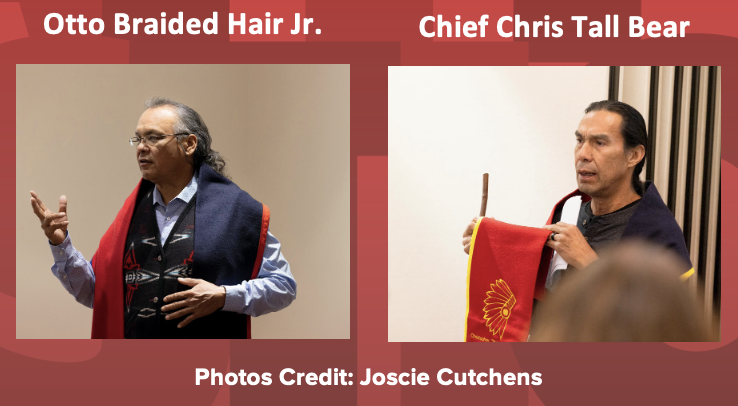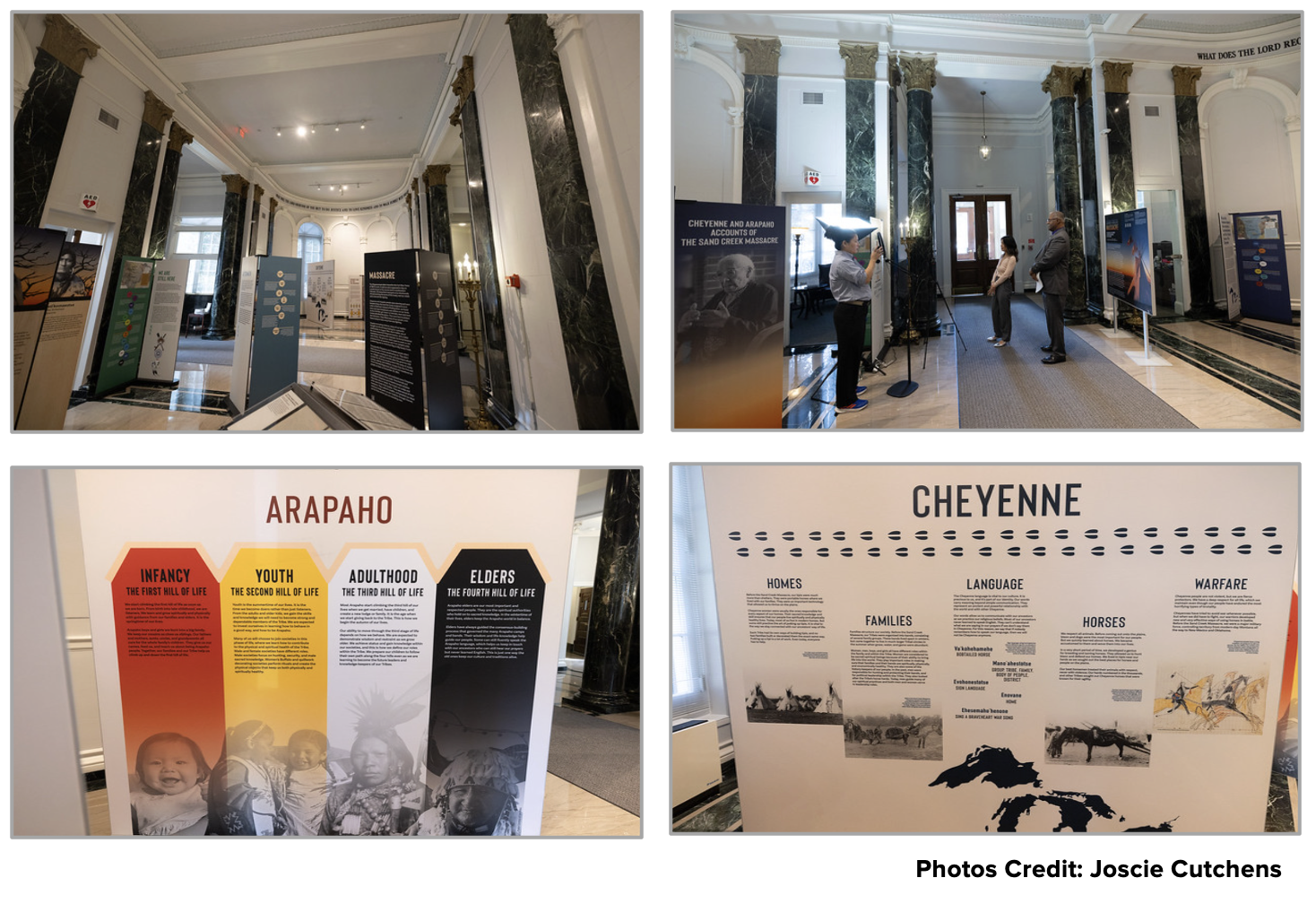Sand Creek Massacre Exhibition Opens in Partnership with History Colorado, Cheyenne and Arapaho Tribes, and The United Methodist Church
Commemorating the exhibit opening at The United Methodist Building, Washington, D.C., United Methodist leaders and Sand Creek Massacre Tribal Representatives held a panel discussion offering remembrance and healing of the massacre.

On November 10, 2025, The General Board of Church and Society (GBCS) and the General Commission on Religion and Race (GCORR) kicked off the opening of the Sand Creek Massacre Exhibition at the United Methodist Building, spotlighting a panel discussion that featured the Sand Creek Massacre Tribal Representatives.
The panel discussion was held to highlight the exhibit at the United Methodist Building and to affirm our shared responsibility to truth, repentance, and repair.

The exhibit called The Sand Creek Massacre: The Betrayal that Changed Cheyenne and Arapaho People Forever was developed by History Colorado together with the three Cheyenne and Arapaho Tribes.
In the early morning hours of November 29, 1864, the Third Colorado Cavalry, made up of 675 men under the command of Colonel John Chivington, a Methodist minister and political opportunist, attacked a peaceful Cheyenne and Arapaho encampment in the bend of Big Sand Creek located in southeastern Colorado Territory, resulting in the deaths of approximately 230 Cheyenne and Arapaho people, most of whom were women, children, and the elders.
In his welcome, Bishop Julius C. Trimble, General Secretary of the General Board of Church and Society stated, “We say clearly: the Church has not always lived its calling to love our neighbors as ourselves. We recognize that our statements of regret must be matched with sustained action, relationship, and humility.”
Rev. Giovanni Arroyo, General Secretary of the General Commission on Religion and Race extended the welcome saying, “This gathering is not only a time to remember the horror of that today but a time to renew our commitment to truth telling, accountability and healing. Remembrance isn’t symbolic; it is relational.”
Richard Church, representing the Committee on Native American Ministries of the Baltimore-Washington Annual Conference, offered a symbolic land acknowledgement, welcoming attendees to the homeland of the Anacostan peoples on which the United Methodist Building stands.
Otto Braided Hair Jr. of Northern Cheyenne-Montana, offered the song sung by White Antelope until the moment of his death in the massacre, repeating the words, “Nothing lives long only the earth and the mountains.”
Dawn DiPrince, President and CEO of History Colorado, remarked, “This exhibit offers universal, timely lessons that fear, racism, greed and stereotyping can, and do, lead to catastrophic consequences. History Colorado is committed to educating communities around the world about this danger. The power of historic truth is that historic truth can change us. Historic truth can heal us. And it is only through historic truth that we can truly build a just and liberated world.”
Bishop Kristin Stoneking of Mountain Sky Episcopal Area and the presiding bishop of the United Methodist Sand Creek Massacre Interagency Task Force added, “United Methodists need to know that we are the spiritual descendants of Methodists that perpetuated atrocities that created layers of generational trauma that remain with us today. In this truth telling, is deep repentance and also responsibility taking.”
Panel Discussion Highlights
The panel discussion was facilitated by Rev. Bryan Tener (Southern Cheyenne), the Director of Contextual Evangelism, Community Engagement, and Church Planting with Path 1 & Discipleship Ministries. Due to flight cancellations, the panel discussion was in hybrid format.
The panelists offered a range of perspectives reflecting the enduring trauma of the Sand Creek massacre, the importance of truth-telling, and the ongoing work of healing.
Panelist Comments

Otto Braided Hair Jr.
Sand Creek Representative of Northern Cheyenne-Montana
“The Sand Creek Massacre exhibition demonstrates that people can work humbly together to remember and begin to heal from atrocities and betrayals such as this.” He expressed appreciation for those gathered and challenged attendees to continue to bring the truth, care, respect, love that Christ wanted you all to do.
Fred Mosqueda (virtual)
Sand Creek Representative, Cheyenne and Arapaho tribes, Oklahoma
Mosqueda shared a story about his grandmother, who, more than 100 years after the massacre, still slept with her moccasins beside her head, “just in case they come and I have to run” a stark reminder of the generational trauma that persists.
Chester Whiteman (virtual)
Sand Creek Representative Cheyenne and Arapaho Tribes-Oklahoma
Whiteman spoke of the many broken promises and treaties that preceded Sand Creek, nothing that the massacre was one of numerous betrayals by the U.S. government and the importance of truthful history telling.
Norma Gourneau (virtual)
Sand Creek Representative of Northern Cheyenne- Montana
Gourneau emphasized the importance of remembrance for future generations: “We have to look back but we also have to look forward. We have to talk about them, so we never forget them. It will never happen again because we don’t want to forget what happened.”
Gail Ridgely (virtual)
Sand Creek Northern Arapaho-Wyoming
“It is imperative the tribes are afforded the opportunity to tell their stories in this space in order to educate the general public, so history doesn’t repeat itself. The Sand Creek Massacre is a place of reverence and creates a space for dialogue and healing among the Cheyenne and Arapaho people”
Chief Chris Tall Bear
Sand Creek Representative Cheyenne and Arapaho Tribes-Oklahoma
Chief Tall Bear invited participants to imagine the national climate leading up to the massacre: manifest destiny, civil war, immigration, American exceptionalism, and racial hierarchy and drew parallels to contemporary issues such as eminent domain, exceptionalism, DEI, and immigration. He connected these issues to the ongoing generational trauma and offered the closing prayer.
Visit The Sand Creek Massacre Exhibit
The exhibit is on display in the United Methodist Building in Washington, D.C., from November 10 to December 1, 2025. We invite you, your congregation, and your community to visit the exhibit to learn more about this tragic chapter in U.S., and Methodist history.

Admission is free, but timed-entry tickets are required.
- The United Methodist Building is open Monday to Friday from 9:00-5:00 PM.
- The first-timed entry is at 9:30 AM and the last timed entry is at 3:30 PM.
- The United Methodist Building is closed for Thanksgiving on November 27 & 28, 2025.
Get your timed entry ticket Here
To learn more, view Sand Creek Massacre programming and resources developed by The General Board of Church and Society and The General Commission on Religion and Race.